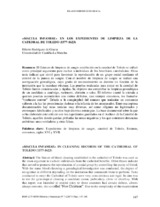Mostrar el registro sencillo del ítem
«Macula infamiae» en los expedientes de limpieza de la catedral de Toledo (1577-1623)
| dc.contributor.author | Rodríguez de Gracia, Hilario | |
| dc.date.accessioned | 2018-02-02T10:07:53Z | |
| dc.date.available | 2018-02-02T10:07:53Z | |
| dc.date.issued | 2017 | |
| dc.identifier.issn | 2173-6030 | |
| dc.identifier.uri | http://hdl.handle.net/10396/16059 | |
| dc.description.abstract | El Estatuto de limpieza de sangre establecido en la catedral de Toledo se utilizó como principal argumento para excluir a individuos de los beneficios catedralicios. Otras tesis indican que sirvió para favorecer la reproducción de un grupo social mediante el control de la pureza de sangre. Con el nombre de limpieza de sangre se realizó una averiguación genealógica, cuyo grado de reconocimiento es distinto en función de la institución que la mandase efectuar. Las pruebas realizadas para entrar en la catedral de Toledo fueron concienzudas y rígidas. Su objetivo era comprobar la limpieza genealógica de un candidato a canónigo, racionero, clerizón o seise. El informe coartó la entrada a quienes poseían ascendientes con ciertos defectos, casi siempre conversos, los llamados “cristianos nuevos”. Debido a la complejidad del examen que realizaba un comisario salieron a la luz las procedencias dudosas o la infamia de los antepasados. Entre esa copiosa documentación hay otras noticias muy diversas, así como orígenes no legitimados y entronques falsificados y ocultos bajo diversas estrategias. La base documental sobre la que se ha elaborado este artículo son los expedientes guardados en el Archivo de la Catedral de Toledo, aquellos donde quedan probadas las notas negativas y los que contienen denuncias anónimas: unas verdaderas y otras falsas. | es_ES |
| dc.description.abstract | The Statute of blood cleaning established in the cathedral of Toledo was used as the main argument to exclude individuals from the cathedral benefits. Other theses indicate that served to promote the reproduction of a social group by controlling the purity of blood. With the name blood cleansing a genealogical investigation was conducted, the degree of recognition is different depending on the institution that commands them to perform. Tests conducted to enter the Cathedral of Toledo were very conscientious and rigid. Its aim was to test the genealogical cleaning a candidate canon, prebendary, cleric or choirboy. With that report was intended to restrict entry to those ancestors had certain defects, almost always converts, the so-called “New Christians”. Due to the complexity of the examination performing a commissioner they came to light questionable provenance or the infamy of the ancestors. Among the copious documentation there is other very diverse news, as well as falsified and hidden under various strategies not legitimated origins and junctions. The documentary basis on which this article has been prepared files is saved in the Archive of the Cathedral of Toledo, where those are tested negative notes and containing anonymous complaints, some true and some. | es_ES |
| dc.format.mimetype | application/pdf | es_ES |
| dc.language.iso | spa | es_ES |
| dc.publisher | Universidad de Córdoba, UcoPress | es_ES |
| dc.rights | https://creativecommons.org/licenses/by-nc-nd/4.0/ | es_ES |
| dc.source | Historia y Genealogía 7, 147-188 (2017) | es_ES |
| dc.subject | Expedientes de limpieza de sangre | es_ES |
| dc.subject | Catedral de Toledo | es_ES |
| dc.subject | Estatuto | es_ES |
| dc.subject | Conversos | es_ES |
| dc.subject | Siglos XVI-XVII | es_ES |
| dc.subject | Records blood cleansing | es_ES |
| dc.subject | Cathedral of Toledo | es_ES |
| dc.subject | Statutes | es_ES |
| dc.subject | Convert | es_ES |
| dc.subject | XVI-XVII centuries | es_ES |
| dc.title | «Macula infamiae» en los expedientes de limpieza de la catedral de Toledo (1577-1623) | es_ES |
| dc.title.alternative | «Macula infamiae» in cleaning records of the cathedral of Toledo (1577-1623) | es_ES |
| dc.type | info:eu-repo/semantics/article | es_ES |
| dc.relation.publisherversion | http://www.uco.es/servicios/publicaciones/revistas/index.php/hyg | es_ES |
| dc.rights.accessRights | info:eu-repo/semantics/openAccess | es_ES |

